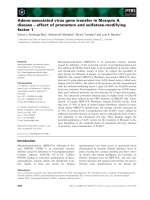Alkaline treatment enhances mass transfer in Protein A affinity chromatography
Bạn đang xem bản rút gọn của tài liệu. Xem và tải ngay bản đầy đủ của tài liệu tại đây (1.99 MB, 7 trang )
Journal of Chromatography A 1673 (2022) 463058
Contents lists available at ScienceDirect
Journal of Chromatography A
journal homepage: www.elsevier.com/locate/chroma
Alkaline treatment enhances mass transfer in Protein A affinity
chromatography
Nico Lingg a, Andreas Daxbacher a, Desiree Womser-Matlschweiger a, Dietmar Pum b,
Jürgen Beck a, Rainer Hahn a,∗
a
Department of Biotechnology, Institute of Bioprocess Science and Engineering, University of Natural Resources and Life Sciences, Vienna, Muthgasse 18,
Vienna 1190, Austria
Department of Nanobiotechnology, Institute of Biophysics, University of Natural Resources and Life Sciences, Vienna, Muthgasse 11, Vienna 1190, Austria
b
a r t i c l e
i n f o
Article history:
Received 28 February 2022
Revised 11 April 2022
Accepted 11 April 2022
Available online 14 April 2022
Keywords:
Mass transfer
Preparative chromatography
Antibody purification
Pore diffusion
Solid diffusion
a b s t r a c t
Cycle stability is important for preparative chromatography resins. Up to 200 cycles have been reported
for Protein A affinity resins when used under optimized operating conditions. Through engineered ligands, alkaline resistant Protein A resins are available that can withstand repeated cleaning-in-place cycles with even 1 M NaOH. This enables an increase of purification cycles through the reduction of fouling
while maintaining high binding capacities. Previously, non-intuitive changes in dynamic binding capacity
after alkaline treatment have been observed for these novel Protein A resins, where sharper breakthrough
curves and increased capacities were reported. In this work, we have systematically investigated resins
with both low and high alkaline stability and studied the changes in static and dynamic binding capacities and elution behavior. We propose that the observed mass transfer increases of up to 40% are due
to a switch in diffusion mechanism, as shown by confocal laser scanning microscopy. Based on our results, only a small window of alkaline treatment conditions exists, where dynamic binding capacity can
be increased. Our findings may help to explain previous findings and observations of others.
© 2022 The Authors. Published by Elsevier B.V.
This is an open access article under the CC BY license ( />
1. Introduction
Protein A affinity chromatography is the backbone of platform
processes for the purification of monoclonal antibodies (mAb) from
cell culture supernatants. One reason for its popularity is the simplicity of the purification scheme: binding at neutral pH and almost completely independent of salt concentration followed by
elution at acidic conditions. Hence, method development is straight
forward and easy, which has contributed to the almost universal application of Protein A affinity chromatography at the core
of antibody platform purification processes. Since the introduction
of the first commercial Protein A resin in 1978, tremendous efforts to improve chromatographic performance were undertaken
and are still continuing today, more than 40 years later [1]. Dynamic binding capacities (DBC) of early resins were in the range of
5–10 g IgG per L and have been increased approximately ten-fold
since [1]. Modern Protein A affinity resins have capacities similar
to other commonly used resins, such as those for ion exchange
and hydrophobic interaction. Numerous comparative studies have
∗
Corresponding author.
E-mail address: (R. Hahn).
been performed and published that document this improvement
over the years [1–9]. This vast capacity increase has been achieved
by several strategies. Recombinant Protein A ligands consisting of
up to 6 domains have been designed and attached to the resins
at ever increasing ligand densities. Moreover, mass transfer resistance was reduced by increasing the pore size, which has led to
improved utilization of the static binding capacity. Steadily increasing IgG production titers in cell culture and a general drive towards
improved process economics have generated a demand of Protein
A resins that can be used over many purification cycles [10]. Together with increased regulatory requirements, this has led to a
demand for efficient cleaning procedures to minimize resin fouling
and to prevent carry-over of impurities. The stability of Protein A
ligand against sodium hydroxide, the most popular reagent for sanitizing and cleaning in place (CIP), has been increased substantially.
This was achieved through genetic engineering tools, e.g. substitution of asparagine and glutamine residues that are responsible for
the structural destabilization of the Protein A domains upon alkaline treatment [11–15]. These improvements have led to stationary
phases that are stable for hundreds of CIP cycles with 0.5–1.0 M
NaOH. However, a very small reduction of binding capacity is observed after each sanitization cycle. Typically, such data is provided
/>0021-9673/© 2022 The Authors. Published by Elsevier B.V. This is an open access article under the CC BY license ( />
N. Lingg, A. Daxbacher, D. Womser-Matlschweiger et al.
Journal of Chromatography A 1673 (2022) 463058
in the data sheet by the manufacturers obtained from long-term
cycling studies.
Several publications deal with the deterioration of Protein A
resins throughout their life-cycle. Pathak and Rathore investigated
the influence of up to 100 purification cycles on MabSelect SuRe
with cell culture supernatant and 50 mM NaOH used for CIP [16].
After 100 cycles, the resin exhibited an earlier and shallower breakthrough curve, resulting in reduced dynamic binding capacity and
mass transfer. They observed a physical film of foulant by transmission electron microscopy (TEM), which led to pore constriction.
Zhang et al. used MabSelect resin in process scale with crude material, which was regenerated with 50 mM NaOH for 20 cycles [17].
A constriction of the pores due to fouling was observed, which
led to a reduction in mass transfer and dynamic binding capacity [18]. This decreased mass transfer was confirmed by confocal
laser scanning microscopy (CLSM). These drastic fouling effects can
be attributed to the low caustic concentrations used for cleaning.
Hahn et al. have shown that fouling effects can be highly dependent on the combination of resin, feed material and cleaning protocol applied [7]. Yang et al. investigated strategies to protect MabSelect and MabSelect SuRe ligands from alkaline degradation [19].
They observed a reduction in affinity of the MabSelect ligand after alkaline treatment with 20 to 200 mM NaOH. This decrease
was mostly driven by an increase in the dissociation rate. They
also observed a reduction in static and dynamic binding capacities, dependent on NaOH concentration after up to 100 purification cycles with purified IgG. The breakthrough curves also show a
change in slope, with new resin having a shallower breakthrough
than alkaline treated resin. Jiang et al. investigated the influence of
alkaline CIP cycles on rProtein A Sepharose Fast Flow and MabSelect resins using pure IgG [20]. These older resins are not alkaline
stable and as such 50–100 mM NaOH was used for cleaning. Adsorption isotherms and breakthrough curves showed a reduction in
static and dynamic binding capacity, and a change in the slope of
IgG breakthrough was observed. The cycled rProtein A Sepharose
FF resin had steeper breakthrough curves than the new material.
The authors hypothesized that this changed slope originated from
altered mass transfer properties and suggested that further investigations are required to unravel the origin of this phenomenon.
While fouling clearly leads to decreased mass transfer due to
pore constriction, the effect of alkaline treatment alone appears
to be more complex. The effects of such CIP treatment on the intrinsic mass transfer mechanism has not been investigated so far.
While CLSM studies exist for cycled Protein A resins [17,18], these
studies did not investigate the effect of alkaline treatment alone.
The purpose of this study was to investigate potential changes of
mass transfer characteristics upon alkaline regeneration with varying NaOH concentrations, in line with the suggestions for further
investigations as proposed by Jiang et al. Additionally, it was intended to reveal differences between the highly alkaline stable
Protein A resin MabSelect PrismA and its predecessor MabSelect
SuRe. To broaden the scope of investigation, a methacrylate-based
resin, Toyopearl AF-rProtein A HC-650F, was also studied. The lig-
ands used in MabSelect and Toyopearl Protein A resins are derived from different domains [15,21,22]. We have used experimental CLSM data and compared them to theoretical CLSM images to
uncover the mass transfer mechanisms [23].
2. Experimental
2.1. Materials and instrumentation
MabSelect SuRe and MabSelect PrismA were purchased from
Cytiva (Uppsala, Sweden) and Toyopearl AF-rProtein A HC-650F
from Tosoh Bioscience (Stuttgart, Germany). The properties of
these resins can be found in Table 1. In this study, two different IgG samples were used: polyclonal IgG was a kind gift from
Octapharma (Vienna, Austria). A monoclonal antibody, an Adalimumab biosimilar, was produced in-house using recombinant CHO
cells. The antibody was purified by Protein A affinity chromatography and the eluate was buffer-exchanged on a Sephadex G25 column (Cytiva). The activated fluorescent dyes for protein labeling,
Rhodamine RedTM-X Succinimidyl Ester and Pacific BlueTM Succinimidyl Ester were obtained from ThermoFisher Scientific, Life
Technologies Corporation (Grand Island, NY, USA). Buffer chemicals were purchased from Merck (Darmstadt, Germany) and SigmaAldrich (St. Louis, MO, USA) if not stated otherwise. Chromatographic runs were performed on an ÄKTA Explorer 100 using resins
packed in Tricorn 5/50 and 5/100 columns (all Cytiva). Confocal
laser scanning microscopy was performed using a Zeiss LSM 510
microscope with a Plan-Apochromat 63x/1.4NA oil objective (Carl
Zeiss MicroImaging, LLC, Thornwood, New York, NY, USA) and a Leica Sp5 microscope with a Plan-Apochromat 40x/0.85 dry objective
(Leica Microsystems, Wetzlar, Germany).
2.2. Methods
2.2.1. Alkaline treatment
Resin packed in columns were treated with NaOH at varying
concentrations and incubation times as stated in the results section. For adsorption isotherms and CLSM measurements, the incubation was instead performed in batch. After the end of the stated
incubation period, the pH was neutralized using an extensive PBS
wash.
2.2.2. Breakthrough curves and linear pH gradient elution
For the determination of the dynamic binding capacity, breakthrough curves (BTC) were performed at varying velocities ranging
from 50 to 600 cm/h. The BTCs were performed in Tricorn 5/100
columns with 1 g/L polyclonal IgG. Two evaluations were used:
firstly, the breakthrough profiles were fitted by a constant pattern
column adsorption model with film and pore diffusion [24] and
secondly, a rearranged model for pore diffusion was used to derive
De from DBC10% data. The equations for this model can be found in
the supporting information. After loading the column, bound IgG
was stripped using 100 mM glycine, pH 2.5.
Table 1
Properties of Protein A resins from Pabst et al. [5]. DBC at 2.4 min residence time.
Parameter
Matrix
MSS
agarose
PrismA
agarose
650F
polymethacrylate
Dp (μm)
rpore (nm)
ε p (NaCl)
ε p (mAb)
EBC (mg/mL)
DBC (mg/mL)
De (10−8 cm²/s)
Protein A ligand progenitor domain (number of repeat units)
89.6
41.8
0.96
0.76
50.2
34.5
4.8
B (4)
54.1
32.7
0.94
0.50
85.4
49.0
1.1
B (6)
54.2
30.8
0.91
0.36
61.5
42.4
1.6
C (6)
2
N. Lingg, A. Daxbacher, D. Womser-Matlschweiger et al.
Journal of Chromatography A 1673 (2022) 463058
Fig. 1. BTCs with IgG on MabSelect SuRe (left panel), MabSelect PrismA (middle panel), Toyopearl AF-rProtein A HC-650F (right panel). Column height was ∼10 cm, velocities
were 75, 150, 200, 300 and 600 cm/h.
Table 2
De and qm values determined from different model fits for the investigated Protein
A resins.
For the study of time and concentration dependent effect of alkaline treatment on DBC10% , a Tricorn 5/50 was used instead. After
reaching the incubation time the column was equilibrated and a
BTC was performed. After the BTC experiment a linear pH gradient
elution run was performed. The same column was subsequently
further incubated to reach the following time of incubation stated
in the results section, i.e. after an initial 12 h incubation the column was incubated for another 12 h to determine the 24 h time
point. The pH gradient was achieved by using a linear gradient of
50 mM citrate buffer from pH 5.5 to 2.5 over 15 column volumes.
The column was loaded with 1 mg IgG per mL packed bed.
Experiment/model fit
Parameter
MSS
PrismA
650F
DBC vs. tR global fit
De
qm
De
qm
De
qm
5.9 × 10−8
47
5.6 × 10−8
58.5
8.0 × 10−8
28.9
2.0 × 10−8
80
1.7 × 10−8
86.5
2.4 × 10−8
74.8
1.9 × 10−8
76
1.7 × 10−8
64
2.2 × 10−8
52
BTC fit before alkaline
treatment
BTC fit after alkaline
treatment
0.5 to 1.0 M respectively. Their binding capacities are also drastically increased compared to the older generation MSS resin,
with DBC10% of over 70 mg/mL at 75 cm/h, compared to
∼40 mg/mL for MSS. Mass transfer, on the other hand seems
to be slower for 650F and PrismA, with a sharper decrease of
DBC at higher velocities. A quantitative analysis was performed
by plotting DBC over residence time and fitting the data with
a pore diffusion model (supporting information Fig. S1). The effective pore diffusion coefficient for PrismA was determined as
De = 2.0 × 10−8 cm−2 /s, which is approximately 3 times lower
than that of MSS (De = 5.9 × 10−8 cm−2 /s). The De for 650F was
1.9 × 10−8 cm−2 /s. These values (Table 2) are in good agreement
with Pabst et al. [5]. In essence, it can be stated that the high binding capacity of PrismA and 650F comes at the cost of reduced mass
transfer rate, as can be seen by the shallower BTCs in Fig. 1. This is
most likely due to differences in the particle and pore size of the
different resins (Table 1).
To explore the alkaline resistance of the three resins, they were
incubated with high concentrations of NaOH over extended periods
of time. Specifically, 0.1 M, 0.5 M and 1 M NaOH was used for MSS,
650F and PrismA, respectively, which correspond to the maximum
concentrations recommended by the manufacturers. BTCs were determined with IgG before and after alkaline treatment. While the
DBC10% of MSS decreased to less than half of its initial value, both
PrismA and 650F show a slight increase in DBC (Fig. 2). Alkaline treatment is expected to result in a decrease of static binding capacity. The observed increase in DBC for PrismA and 650F
could therefore be a result of increased mass transfer. To quantify the effect of alkaline treatment on static binding capacity and
mass transfer, PrismA was incubated with high NaOH concentrations (0.85, 0.95 and 1.0 M) for up to 48 h. BTCs were performed
with IgG on the treated resin and the static binding capacity (qm )
and De were determined, with an emphasis on fitting the early
breakthrough well (see supplementary material Fig. S2). It has to
be noted that the fitted De values on the BTC are not identical to
the values determined with the DBC versus residence time fit (see
Table 2), but the values are still in the range reported by Pabst
et al. [5]. To explore the influence of time and NaOH concentration on an alkaline resistant resin, PrismA was treated with 0.85,
0.95 and 1 M NaOH for 24, 36 and 48 h. A negative effect of alkaline treatment on qm can be seen in Fig. 3A, were static binding
2.2.3. Adsorption isotherms
All experiments were performed in 2 mL vials at room temperature in triplicates. Stock solutions of IgG and a 50% (v/v) resin
slurry were prepared. 25, 50 or 75 μL of slurry was added to a
solution volume of 925, 950 or 975 μL to reach a total volume
of 10 0 0 μL in different vials which were then rotated end-of-end
described above. The solution was filtered through a 0.22 μm syringe filter (SLGVX13NL, Millex-GV filter, Merck, Darmstadt, Germany) and analyzed by UV-VIS photometry at 280 nm assuming
an extinction coefficient of 1.4 for IgG. Calculation of bound protein was performed by mass balance. Experimental data was fitted
by the Langmuir adsorption isotherm to obtain the values for the
equilibrium association constant Ka and maximum binding capacity qm . The adsorption isotherms were determined with native and
alkaline treated resin, as described above.
2.2.4. Confocal laser scanning microscopy
Pure IgG was labelled following the supplier instructions. In
brief, IgG was incubated in a pH 8.5 sodium bicarbonate buffer
with a dye-to-protein molar ratio of 1:3 for 1 h at room temperature in the dark. After reaction, unreacted dye was separated by
size exclusion chromatography using a PD-10 DG desalting column.
Average labeling ratios of 22–24% were obtained.
Batch CLSM experiments were done by placing resin in vials
containing 1.5 mL of each labeled protein diluted with sufficient
unlabeled protein to yield a final dye-to-protein ratio of 1:40, and
rotated end-over-end on a rotator. At periodic time intervals, small
samples were removed from the vials and rapidly centrifuged at
13,0 0 0 rpm for 30 s to separate the resin from the supernatant.
Ratios of resin to protein were chosen to change the protein concentration in the supernatant by a maximum of 10%.
3. Results and discussion
General mass transfer properties of MabSelect SuRe (MSS),
MabSelect PrismA (PrismA) and Toyopearl AF-rProtein A HC-650F
(650F) were assessed by breakthrough curves (BTC). Columns
with 1–2 mL bed volume were overloaded with IgG at varying linear velocities (Fig. 1). The newer generation resins, 650F
and PrismA, are both resistant to high concentrations of NaOH,
3
N. Lingg, A. Daxbacher, D. Womser-Matlschweiger et al.
Journal of Chromatography A 1673 (2022) 463058
Fig. 2. BTCs with IgG on MabSelect SuRe (left panel), MabSelect PrismA (middle panel), Toyopearl AF-rProtein A HC-650F (right panel) after varying incubation time with
1 M NaOH. Column height was ∼10 cm, velocity was 100 cm/h.
Fig. 3. Time and concentration dependent effect of alkaline treatment on MabSelect PrismA. Incubation with 0.85 M, 0.9 M and 1,0 M NaOH was performed for 24, 36 and
48 h, respectively. qm (mg IgG adsorbed per mL bed volume) and De (cm2 /s) were obtained from fitting the experimental profiles with a pore diffusion model as shown in
Fig. S2.
capacity is decreased by ∼15% after incubation with 0.95 M NaOH
for 48 h. The apparent De increases with caustic concentration and
prolonged incubation time. This suggests that mass transfer of the
resin is increasing.
Adsorption isotherms were determined to investigate if binding affinities were influenced by alkaline treatment for the resins
that showed higher alkaline stability in Fig. 2. Based on the results
shown in Fig. 3 for PrismA, alkaline treatment was performed with
1.0 M NaOH for 36 h. For 650F exposure was arbitrarily reduced to
0.5 M NaOH for 10 h, respectively, due to the lower stability indicated by the supplier. Both native resins show typical rectangular
Langmuir adsorption behavior, as expected for affinity chromatography. After alkaline treatment, both resins exhibited a decreased
qm and Ka , i.e. both the binding affinity and maximum capacity
were affected negatively (Fig. 4). Nonetheless, the measured affinities can still be considered as very high. In Fig. 4, results are shown
for mAb. Similar results were obtained with polyclonal IgG (supporting information Fig. S3). Such a decrease in affinity after alkaline treatment was also shown by Yang et al. for MabSelect ligand
with surface plasmon resonance [19]. The kinetics of IgG binding to
Protein A are still extremely fast, so no kinetic binding effects can
be expected. To obtain further insight into changes of intraparticle
transport, intraparticle antibody uptake curves were measured by
CLSM.
This was only possible for the agarose based MSS and PrismA
resins. Due to the opacity of the methacrylate backbone of 650F,
CLSM measurements are not possible under the same conditions as
the agarose-based resins. The comparison of uptake profiles for the
IgG is shown in Figs. 5A and 6A for MSS and PrismA respectively.
Both resins exhibit typical sharp profiles with a shrinking core
which is typical for pore diffusion and highly favorable isotherm.
Faster mass transfer of MSS is clearly visible despite the smaller
particle diameter of PrismA. In Figs. 5C and 6C the uptake of the
IgG on MSS and PrismA, which had been exposed to 0.5 M or 1.0 M
NaOH for 44 h are shown. The profiles do not show sharp fronts
but progressively become more diffuse (smoother) and eventually
reach the core of the particles much faster. The intensity of the saturated particle is reduced, suggesting lower saturation and thus capacity since both channels were recorded with the same laser settings. The very diffuse adsorption front is indicative for two situations: (1) pore diffusion with less favorable isotherm or (2) partial
or complete surface diffusion. Based on the adsorption isotherm
data (Fig. 4) the latter is the more likely mechanism.
Artificial CLSM images were used to uncover the underlying
transport mechanisms observed in Figs. 5 and 6. The artificial images were created based on previously developed methodology by
Beck et al. [23]. Pore and solid diffusion parameters were selected
to match the overall observed De values from BTC experiments and
to match the experimental CLSM images. As shown in Figs. 5B and
6B, a good match between artificial and experimental adsorption
fronts can be achieved for untreated MSS and PrismA by using a
pore-diffusion-controlled mass transfer regime. Notably, adsorption
fronts in PrismA at 60 and 120 min become more diffuse than expected for pore diffusion-controlled mass transfer, which is generally dominated by a shrinking core behavior. When simulating
the adsorption profiles for alkaline treated resin, the diffuse protein
front cannot be achieved by pore diffusion alone (Figs. 5D and 6D),
especially when using the high Ka values from experimental adsorption isotherms (see Fig. 4). To simulate the adsorption profiles
for alkaline treated resin, parallel diffusion with a reduced pore
diffusion coefficient and a considerable solid diffusion term is able
to match the experimental results (Figs. 5F and 6F), while parallel
diffusion with unchanged pore diffusion terms cannot (Figs. 5E and
6E). For alkaline treated PrismA, the artificial CLSM images with
parallel diffusion are again a good match for the first 30 min, but
adsorption profiles for 60- and 120 min deviate. We hypothesize
that this slow mass transfer in the center of the pore could be due
to increasing steric hindrance upon adsorption and reduced accessibility. Prior research by Pabst et al. suggests that PrismA has a
more restrictive pore network as evidenced by the relatively low
4
N. Lingg, A. Daxbacher, D. Womser-Matlschweiger et al.
Journal of Chromatography A 1673 (2022) 463058
Fig. 4. Adsorption isotherms of monoclonal IgG on top MabSelect PrismA and bottom Toyopearl AF-rProtein A HC-650F left before and right after alkaline treatment for 36
and 10 h, respectively. The value q refers to adsorbed IgG per mL resin volume.
Fig. 5. CLSM of MabSelect SuRe before and after alkaline treatment. A and C show experimental CLSM pictures, whereas B, D, E and F represent artificial CLSM images. The
observed effective pore diffusion coefficient De from BTCs is given for the experimental CLSM pictures. For the artificial images, the pore diffusion coefficient Dp and the
solid diffusion coefficient Ds of the underlying model are given.
5
N. Lingg, A. Daxbacher, D. Womser-Matlschweiger et al.
Journal of Chromatography A 1673 (2022) 463058
Fig. 6. CLSM of MabSelect PrismA before and after alkaline treatment. A and C show experimental CLSM pictures, whereas B, D, E and F represent artificial CLSM images.
The observed effective pore diffusion coefficient De from BTCs is given for the experimental CLSM pictures. For the artificial images, the pore diffusion coefficient Dp and the
solid diffusion coefficient Ds of the underlying model are given.
Fig. 7. Linear pH gradient elution of mAb on MabSelect PrismA (left panel) and Toyopearl AF-rProtein A HC-650F (right panel) after varying alkaline treatment.
εp value for mAb of 0.5 compared to 0.94 for NaCl [5]. MSS on the
other hand has a much higher ε p of 0.7 for mAb.
for PrismA and 650F, respectively (Fig. 7). A shift towards later retention volume, by approximately 1 column volume, was observed
for alkaline treated resin. This suggests that the desorption behavior of the ligand is also affected by the alkaline treatment. We also
investigated if a change in porosity could be responsible for the
observed differences. A salt pulse performed before and after alkaline treatment (Fig. S4) did not indicate any changes in intraparticle porosity. However, this retention time shift seems to be
contrary to the adsorption behavior as lower pH is required for
elution indicating high binding strength at acidic conditions. One
possible explanation might be deamidation of glutamine and asparagine residues into glutamate and aspartate on the Protein A
ligand [25]. Binding at neutral pH would then be affected by the
newly created negative charges in the Protein A ligand, resulting
in the observed decrease in binding affinity. Furthermore, a deamidated ligand would require a lower pH to be fully protonated and
The emergence of significant solid diffusion after alkaline treatment might be related to the increase of the desorption rate koff in
alkaline treated Protein A ligand, that was observed by Yang et al.
in SPR assays [19]. They observed that the decrease in affinity constant Ka was driven by this increase in koff and not a decrease in
adsorption rate kon . Our own data (Fig. 4 and supporting information Fig. S3) confirm a slightly reduced, but still very high affinity
of IgG for the ligand. This results in high partitioning of IgG into
the solid phase, but higher mobility due to increased koff , enabling
surface diffusion.
The effect of alkaline treatment on elution behavior of antibodies was investigated on PrismA and 650F resins. Elution of IgG with
a linear pH gradient was performed at the start and the end of the
treatment but also after intermediate time points of 24 h and 5 h
6
N. Lingg, A. Daxbacher, D. Womser-Matlschweiger et al.
Journal of Chromatography A 1673 (2022) 463058
thus uncharged, to elicit elution. Further studies on a molecular
level would be required to confirm this hypothesis.
It has to be noted that the alkaline treatment used in this study
differs from regular industrial procedure. Instead of using repeated
30 min exposure cycles, we have simulated the repeated CIP stress
by a single prolonged incubation. A final consideration is related
to a change of pore structure. An investigation of the beads with
SEM proofed difficult and showed inconclusive results. Obtaining
reproducible micrographs that allow to compare the pore structure of even the same bead is challenging. Accordingly, no change
in pore structure or diameter between virgin and alkaline treated
material was observed (supporting information Fig. S5). A TEM inspection such as those performed by Zang et al. [17,18] and Pathak
and Rathore [16] could be informative in this respect but was not
available for the present study.
[4] Z. Liu, S.S. Mostafa, A.A. Shukla, A comparison of Protein A chromatographic
stationary phases: performance characteristics for monoclonal antibody purification, Biotechnol. Appl. Biochem. 62 (1) (2015) 37–47, doi:10.1002/bab.1243.
[5] T.M. Pabst, J. Thai, A.K. Hunter, Evaluation of recent Protein A stationary phase
innovations for capture of biotherapeutics, J. Chromatogr. A 1554 (2018) 45–60,
doi:10.1016/j.chroma.2018.03.060.
[6] M. Grom, M. Kozorog, S. Caserman, A. Pohar, B. Likozar, Protein A affinity chromatography of Chinese hamster ovary (CHO) cell culture broths containing
biopharmaceutical monoclonal antibody (mAb): experiments and mechanistic
transport, binding and equilibrium modeling, J. Chromatogr. B Analyt. Technol.
Biomed. Life Sci. 1083 (2018) 44–56, doi:10.1016/j.jchromb.2018.02.032.
[7] R. Hahn, K. Shimahara, F. Steindl, A. Jungbauer, Comparison of Protein A affinity sorbents III. Life time study, J. Chromatogr. A 1102 (1–2) (2006) 224–231,
doi:10.1016/j.chroma.2005.10.083.
[8] M. Zarrineh, I.S. Mashhadi, M. Farhadpour, A. Ghassempour, Mechanism of antibodies purification by Protein A, Anal. Biochem. 609 (2020) 113909, doi:10.
1016/j.ab.2020.113909.
[9] S. Hober, K. Nord, M. Linhult, Protein A chromatography for antibody purification, J. Chromatogr. B Analyt. Technol. Biomed. Life Sci. 848 (1) (2007) 40–47,
doi:10.1016/j.jchromb.2006.09.030.
[10] A. Gronberg, M. Eriksson, M. Ersoy, H.J. Johansson, A tool for increasing the
lifetime of chromatography resins, MAbs 3 (2) (2011) 192–202, doi:10.4161/
mabs.3.2.14874.
[11] B. Nilsson, T. Moks, B. Jansson, L. Abrahmsen, A. Elmblad, E. Holmgren, C. Henrichson, T.A. Jones, M. Uhlen, A synthetic IgG-binding domain based on staphylococcal Protein A, Protein Eng. 1 (2) (1987) 107–113, doi:10.1093/protein/1.2.
107.
[12] R. Li, V. Dowd, D.J. Stewart, S.J. Burton, C.R. Lowe, Design, synthesis, and
application of a Protein A mimetic, Nat. Biotechnol. 16 (2) (1998) 190–195,
doi:10.1038/nbt0298-190.
[13] M. Linhult, S. Gulich, T. Graslund, A. Simon, M. Karlsson, A. Sjoberg, K. Nord,
S. Hober, Improving the tolerance of a Protein A analogue to repeated alkaline
exposures using a bypass mutagenesis approach, Proteins 55 (2) (2004) 407–
416, doi:10.1002/prot.10616.
[14] K. Minakuchi, D. Murata, Y. Okubo, Y. Nakano, S. Yoshida, Remarkable alkaline stability of an engineered Protein A as immunoglobulin affinity ligand:
c domain having only one amino acid substitution, Protein Sci. 22 (9) (2013)
1230–1238, doi:10.1002/pro.2310.
[15] E. Muller, J. Vajda, Routes to improve binding capacities of affinity resins
demonstrated for Protein A chromatography, J. Chromatogr. B Analyt. Technol.
Biomed. Life Sci. 1021 (2016) 159–168, doi:10.1016/j.jchromb.2016.01.036.
[16] M. Pathak, A.S. Rathore, Mechanistic understanding of fouling of Protein A
chromatography resin, J. Chromatogr. A 1459 (2016) 78–88, doi:10.1016/j.
chroma.2016.06.084.
[17] S. Zhang, W. Daniels, J. Salm, J. Glynn, J. Martin, C. Gallo, R. Godavarti, G. Carta,
Nature of foulants and fouling mechanism in the Protein A MabSelect resin
cycled in a monoclonal antibody purification process, Biotechnol. Bioeng. 113
(1) (2016) 141–149, doi:10.1002/bit.25706.
[18] S. Zhang, K. Xu, W. Daniels, J. Salm, J. Glynn, J. Martin, C. Gallo, R. Godavarti,
G. Carta, Structural and functional characteristics of virgin and fouled Protein A
MabSelect resin cycled in a monoclonal antibody purification process, Biotechnol. Bioeng. 113 (2) (2016) 367–375, doi:10.1002/bit.25708.
[19] L. Yang, J.D. Harding, A.V. Ivanov, N. Ramasubramanyan, D.D. Dong, Effect of
cleaning agents and additives on Protein A ligand degradation and chromatography performance, J. Chromatogr. A 1385 (2015) 63–68, doi:10.1016/j.chroma.
2015.01.068.
[20] C. Jiang, J. Liu, M. Rubacha, A.A. Shukla, A mechanistic study of Protein A
chromatography resin lifetime, J. Chromatogr. A 1216 (31) (2009) 5849–5855,
doi:10.1016/j.chroma.2009.06.013.
[21] Tosoh, TOYOPEARL AF-rProtein A-650F product description, 2021. https:
//www.separations.eu.tosohbioscience.com/solutions/process- media- products/
by-mode/protein-a/toyopearl-af-rprotein-a-650f. (Accessed 2021-12-10).
[22] Cytiva, Benchmarking study: alkaline stability of modern Protein A chromatography resins, 2021. />bioprocessing/knowledge- center/alkaline- stability- of- protein- a- affinity- resins.
(Accessed 2021-12-10).
[23] J. Beck, E. von Lieres, N. Zaghi, S. Leweke, G. Carta, R. Hahn, Patterns of
protein adsorption in ion-exchange particles and columns: evolution of protein concentration profiles during load, hold, and wash steps predicted for
pore and solid diffusion mechanisms, J. Chromatogr. A 1653 (2021) 462412,
doi:10.1016/j.chroma.2021.462412.
[24] T.W. Weber, R.K. Chakravorti, Pore and Solid diffusion models for fixed-bed
adsorbers, Aiche J. 20 (2) (1974) 228–238 DOI, doi:10.10 02/aic.69020 0204.
[25] M. Wetterhall, M. Ander, T. Bjorkman, S. Musunuri, R. Palmgren, G. Rodrigo,
Investigation of alkaline effects on Protein A affinity ligands and resins using
high resolution mass spectrometry, J. Chromatogr. B Analyt. Technol. Biomed.
Life Sci. 1162 (2021) 122473, doi:10.1016/j.jchromb.2020.122473.
4. Conclusion
Breakthrough curves of next generation Protein A resins become steeper after alkaline treatment, eventually leading to increased dynamic binding capacity. This stems from an increase of
mass transfer, driven by a change from pore to parallel diffusion.
Slight ligand degradation leads to a contribution of solid diffusion
as shown by analyzing the intraparticle adsorption profiles. Alkaline treatment does not appear to change the pore structure of the
bead. The ligand degradation also impacts elution behavior, leading to a lower pH for complete elution. This behavior can be critical after prolonged resin cycling, when full recovery cannot be
reached with standard elution conditions. Finally, our findings can
help explain anomalous mass transfer and elution effects observed
in large scale production with cycled alkaline resistant resins.
Declaration of Competing Interest
The authors declare that they have no known competing financial interests or personal relationships that could have appeared to
influence the work reported in this paper.
CRediT authorship contribution statement
Nico Lingg: Conceptualization, Writing – original draft, Writing
– review & editing. Andreas Daxbacher: Investigation, Methodology. Desiree Womser-Matlschweiger: Investigation, Methodology.
Dietmar Pum: Investigation, Methodology. Jürgen Beck: Formal
analysis, Methodology, Visualization. Rainer Hahn: Conceptualization, Methodology, Resources, Writing – original draft, Writing –
review & editing, Supervision, Visualization.
Supplementary materials
Supplementary material associated with this article can be
found, in the online version, at doi:10.1016/j.chroma.2022.463058.
References
[1] G.R. Bolton, K.K. Mehta, The role of more than 40 years of improvement in
Protein A chromatography in the growth of the therapeutic antibody industry,
Biotechnol. Prog. 32 (5) (2016) 1193–1202, doi:10.1002/btpr.2324.
[2] R. Hahn, R. Schlegel, A. Jungbauer, Comparison of Protein A affinity sorbents,
J. Chromatogr. B Analyt. Technol. Biomed. Life Sci. 790 (1–2) (2003) 35–51,
doi:10.1016/s1570-0232(03)0 0 092-8.
[3] R. Hahn, P. Bauerhansl, K. Shimahara, C. Wizniewski, A. Tscheliessnig, A. Jungbauer, Comparison of Protein A affinity sorbents II. Mass transfer properties, J.
Chromatogr. A 1093 (1–2) (2005) 98–110, doi:10.1016/j.chroma.2005.07.050.
7









